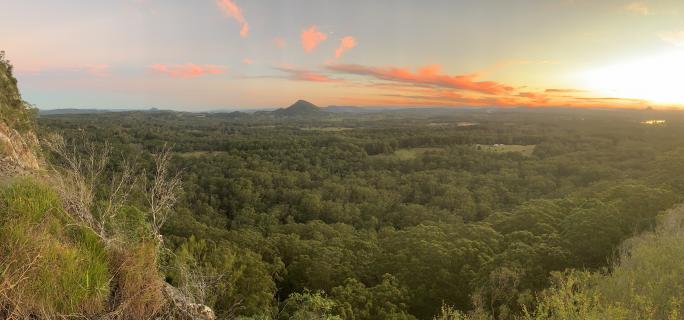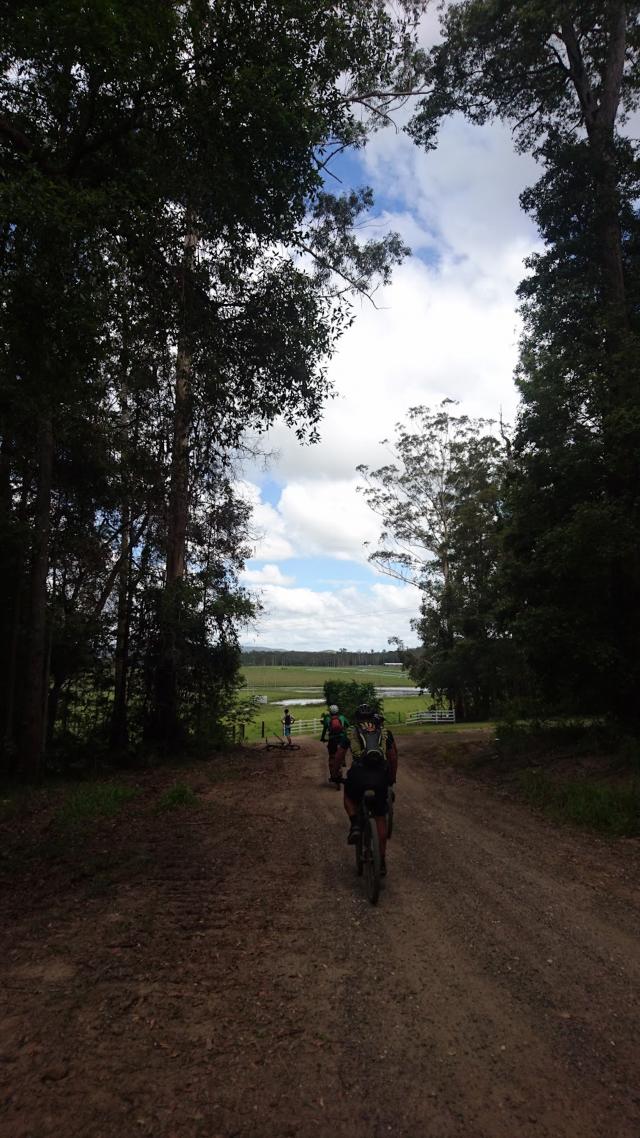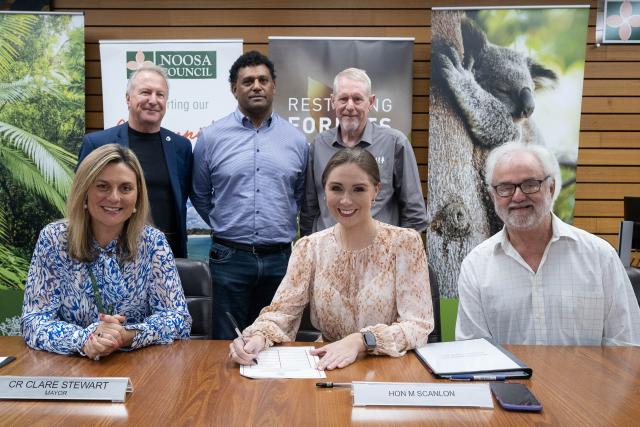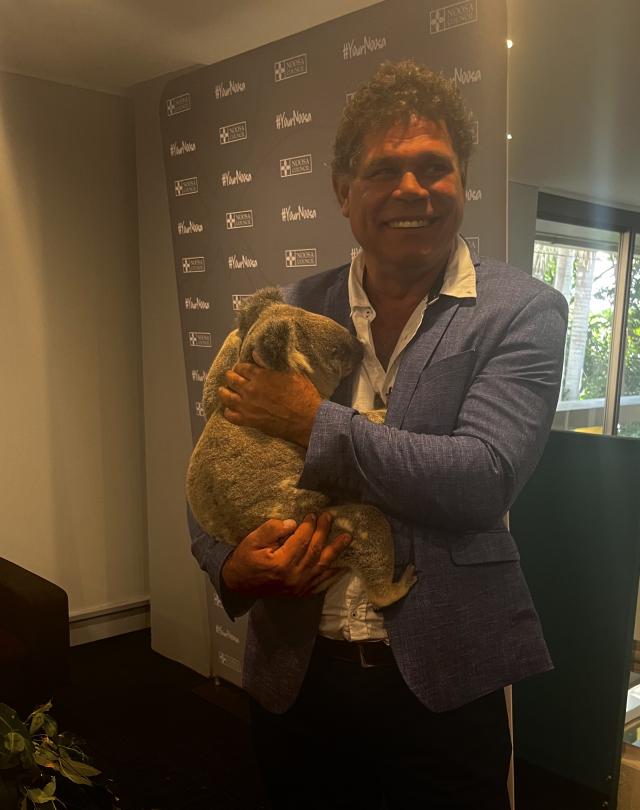Precede:
Yurol Ringtail has been described as the last big environmental land project that Noosa Shire will see, but few people understand its importance or how it came to be. PHIL JARRATT reports.
While the pollies and the bureaucrats were backslapping each other over tea and scones at Noosa Council chambers the other day, the real celebration of the Yurol Ringtail Conservation Project was happening out in the soggy forest itself, where 34 koalas had been located.
This important indicator of the significance of the project was reported by Noosa and District Landcare officer Rachel Lyons the night after the celebration.
Using heat sensor cameras on drones across six sample areas of the 2400 hectares of former forestry and plantation land, Rachel and her team had made this small but significant discovery. Extrapolating the finding to current vegetated areas across the project area, that amounts to a current koala population of 286, with an expectation of 528 living in the Yurol-Ringtail habitat by the time the revegetation work is complete.
Koala restoration is just one of many exciting elements expected to arise as we near completion of the final, huge piece of the jigsaw puzzle that is Noosa’s crescent of green.
Yurol-Ringtail is perhaps best understood by taking a hinterland drive. From Tewantin, head out along McKinnon Drive towards Boreen Point. To your left, with the exception of a few private properties, all the forest you see is part of the new park.
At Louis Bazzo Drive go left. The forest you see to either side is parkland all the way to the outskirts of Pomona.
From Pomona to Cooroy, the forest to the left is parkland.
Take the Cooroy-Noosa Road towards Tewantin. From Tinbeerwah to the bottom of the escarpment, the forest to both sides is parkland. A thousand hectares of this 2400-hectare addition is already national park, a lot of it is self-restoring, and about 100 hectares is being helped along.
Welcome to Yurol-Ringtail.
But strangely, few people outside a small cohort who helped create it seem to know much about this extraordinary achievement.
The story begins about a decade ago, during the last grim days of the de-amalgamation battle for Noosa to get its shire back, when Noosa Parks Association veteran Michael Gloster and members of the NPA leadership team sat down and worked out the key headland projects that would need to be delivered over the long term to create a strong case for Noosa’s World Heritage listing.
Michael Gloster recalls: “The first one was bringing back the health of the river. The second one was linking Noosa, Cooloola and Tewantin national parks as a single 100,000-hectare national park estate.
“To put this in context, when NPA set up shop 60 years ago, there was only 240 hectares on Noosa Headland, but over the previous decade or so, we gradually added bits in what is now known as Tewantin National Park.
“Surrounding the rest was state forest, mostly pine plantation. We came to the realisation that to build our case, we had to buy back the land, convert it to hardwood and make it national park.”
The Yurol–Ringtail acquisition, delivered in 2018, effectively seals Noosa forever within a crescent of protected national parks and wildlife corridors, creating a wilderness refuge of international standing and huge economic benefit at very little cost.
It is not quite the final link – there are still 200 hectares to obtain – but as former Noosa mayor Tony Wellington told this writer soon after the acquisition: “This is probably the last really big environmental land project that Noosa Shire will see. I am very proud that it happened on my watch, that I was a part of developing the deal, and that the council I led supported such a grand scheme.”
But the deal hadn’t been easy.
During the Beattie and Bligh Queensland Labor governments in the first decade of this century, the state plantation forests were privatised, which was a devastating blow for Noosa Parks Association.
Says Gloster: “We had all the state forest plantations in Noosa Shire on our hit list for revegetation as native forests and transfer to a future Tewantin National Park.
“I sulked for a couple of years about the Beattie–Bligh governments’ sell-out, but there was a Eureka realisation that the forests we wanted were now owned by a global company called Hancock, run out of Boston, and it’s always easier to deal with pragmatic commercial interests rather than state bureaucracies.”
Did Hancock really want to hold onto a couple of thousand hectares in Noosa, or would it sell if the price was right?
Gloster decided to find out.
Local management was unresponsive, but the parent company of HQ Plantations, which owned the leases on the forests in question, was Hancock Timber Resource Group, the world’s largest manager of ethical timberland investments, with more than US $50 billion under management. Gloster went right to the top and pleaded the case.
Again, nothing happened.
Gloster takes up the story: “Then out of the blue Brian Farmer, the CEO of Hancock Queensland Plantations, phoned me and invited me to lunch, where he told me it would cost $3.5 million. I knew it was do-able. But I knew I had to line up a lot of ducks quickly.”
Firstly, Michael Gloster needed to ensure that Queensland Parks and Wildlife Service management would support the addition of revegetated state forest plantations to Tewantin National Park, then he needed the support of the Department of Environment and Science, which includes QPWS in its portfolio, and the Department of Agriculture and Fisheries, which has state forests and overseeing HQ Plantations in its portfolio.
He enlisted the help of Noel Playford, who had a long contact list from his days chairing the Local Government Association of Queensland, to set up meetings with the departmental heads.
Says Gloster: “Noel accompanied me to each meeting, and the departmental bosses gave unequivocal support, including a willingness to recommend to their Ministers that the state join with NPA as equal financial partners in buying out HQ, as long as Noosa Council joined in for an equal share.
“I then met with Mayor Wellington and Council CEO Brett de Chastel who indicated their personal approval and agreed to take it to council.”
The bare bones of a deal between HQ Plantations, the state, Noosa Council and NPA, which concerned the three entities equally funding the $3.5 million acquisition, were stitched together within a couple of weeks, but it would take many months of hard yakka before formal legal contracts could be signed.
Along the way, public servants and council officers overcame obstacle after obstacle, with de Chastel the rock-solid anchorman who kept things ticking along.
But the most remarkable aspect of the deal was how a community organisation, Noosa Parks Association, could stump up a third of the money.
Michael Gloster explains: “Since the turn of the century, the NPA had developed a business model that is an exemplar for environmental protection groups everywhere. It runs information centres at the Noosa National Park and the historic lighthouse cottage at Double Island Point, and the proceeds from these businesses go into a fund for the acquisition of land for national parks.
“There are some expenses, but the net return is about $150,000 a year. This enabled NPA to join with Noosa Shire Council and the Queensland Government as equal partners in protecting forever Noosa’s surrounding green belt.”
Speaking at the Yurol project’s celebration last week, Mayor Clare Stewart emphasised the historic collaboration that had allowed it to happen, and also acknowledged former mayors Playford and Wellington, “who were involved with this project from inception and are with us today”.
But while acknowledging the past, she and other speakers also celebrated a future in which the Kabi Kabi First Nations and the Greenfleet Australia corporation would play key roles in the restoration and management of the parklands, with Greenfleet providing the funding through carbon credits from removing 700,000 tonnes of carbon from Noosa, while the Kabi Kabi Peoples Aboriginal Corporation would provide the workforce.
As Kabi Kabi chair Norman Bond noted: “Kabi Kabi look forward to working with Greenfleet and Noosa Landcare in providing training and future employment opportunities for our people, and long-term protection of our country.”
It seems fitting to give the last word to Michael Gloster, the architect of the Yurol-Ringtail deal and now vice-president of Noosa Parks Association.
He told the Council celebration: “We had to come up with a way to convert plantation forest to national park and we learnt about biodiversity and carbon sequestration as we went, then out of the blue, Greenfleet offered to fund the restoration through carbon offsets.
“But it’s only been quite recently that we came to grips with Native Title and the prospect of co-operative management of the whole estate.
“It’s a humbling prospect, because Kabi Kabi have been here for at least 18,000 years, so they’ve been involved 300 times longer than we have.
“We take great pride in what we’ve achieved but we’re also humbled by what is in front of us – a many-hands approach to caring for country, with Kabi Kabi at the forefront. And we know it’s going to work as an incredible and perpetual legacy project.
“So that’s what we celebrate today – a five-way partnership to care for country.”





![[READER COMPETITION] – Win tickets to see Sharon and Slava Grigoryan present ‘OUR PLACE’](https://noosatoday.com.au/wp-content/uploads/2025/07/sharon-and-slavav-324x235.png)




